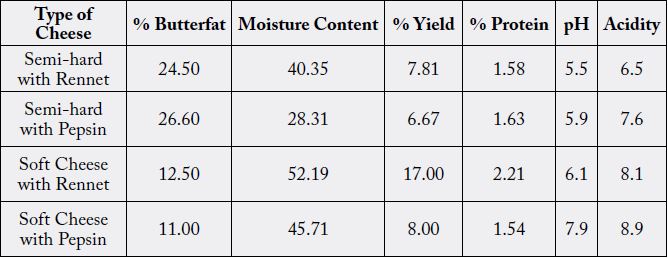Biography
Interests
Obinna, V. O.1* & Odo, P. C.2
1Department of Food Technology, Akanu Ibiam Federal Polytechnic, Unwana Ebonyi State
2Department of Food Technology, Federal Polytechnic, Nekede Imo State
*Correspondence to: Dr. Obinna, V. O., Department of Food Technology, Akanu Ibiam Federal Polytechnic, Unwana Ebonyi State.
Copyright © 2018 Dr. Obinna, V. O., et al. This is an open access article distributed under the Creative Commons Attribution License, which permits unrestricted use, distribution, and reproduction in any medium, provided the original work is properly cited.
Abstract
Chicken pepsin was tried in the production cheese as a replacement for rennet, which is conventionally used as a coagulant in cheese production. 8 litres of milk was purchased from pastoral Fulanis in Afikpo and was pasteurised at 72°C for 15 seconds and cooled to 32°C. After the cooling, the pasteurised milk was shared into two portions. 10% of cheese culture was added followed by the addition of CaCl2 solution while another 10% of chicken pepsin extracted from the gizzard of a chicken was then added to the second portion. The milk portions were well stirred for about a minute and then left in a water bath, maintaining the temperature at 32°C until coagulation was achieved. Results show that semi-hard cheese made with chicken pepsin as a coagulating enzyme has more butterfat (26%) than that from the traditional calf rennet (24.5%). However, soft cheese resulting from the use of chicken pepsin has lower butterfat (11%) than that from the rennet enzyme (12.5%). The yield of soft cheese from chicken pepsin is less than that of half (8%) from rennet enzyme. The highest loss of protein was recorded in the whey of semi-hard cheese from rennet enzyme. The sensory evaluation results show that all the varieties of cheese were acceptable to the investigating panellists. The research concludes that a good and acceptable quality cheese could be produced using pepsin extracted from chicken gizzard. It is recommended that chicken pepsin be exploited as this would further enhance the value chain of poultry products.
Introduction
Cheese making is an ancient craft, which dates far back in the early centuries but still retains its original
method even when practised in the most modern industries. Cheese is one of the dairy products made by the
process of coagulating milk using an enzyme preparation called rennet. The various types of cheeses all differ
in physical, chemical and organoleptic properties because of the variations in their method of manufacture.
Cheese can be made using milk from cow, goat, or sheep. Some varieties of are made from whey. The various types of cheese can be broadly grouped into ‘‘hard’’ and ‘‘soft’’ cheeses.
Farmers produce large quantity of milk especially in the northern part of Nigeria, which they cannot consume at ones. These producers cannot also keep the quantity in good condition as milk very quickly go bad. The easiest way to preserve the milk is to transform it into cheese but the farmers cannot afford the calf rennet on grounds of its prohibitive cost. Successful use of alterative cheaper and more available milk coagulant like pepsin extracted from the gizzard of chickens in cheese making will be of great benefit to the society as it will extend the use of milk.
Materials and Methods
About 8 litres of milk was purchased from pastoral Fulanis in Afikpo was pasteurised at 72°C for 15
seconds and cooled to 32°C. After the cooling, 10% of cheese culture was added followed by the addition
of CaCl2 solution. The milk was well stirred for about a minute and then left in a water bath, maintaining
the temperature at 32°C until coagulation was achieved. The curd was cut both vertically and horizontally
to obtain cubes. About 40% of the whey was drained before it was cooked for 30 minutes at 42°C. The curd
was further drained and filled into cheese mould lined with cheese cloth and pressed overnight. It was then
removed from the mould and immersed in brine solution for 6 hours. After this period, the cheese was left
to mature at room temperature for 30 - 40 days. The same procedure was adopted for making semi-hard
cheese with chicken pepsin.
Results and Discussion
The conventional calf rennet and pepsin extracted from the gizzard of a chicken were comparatively used
as milk coagulants. Samples of cheese and whey were collected and analysed for cheese quality attributes.
Sensory evaluation of the matured cheeses was carried out. Results show that semi-hard cheese made with
chicken pepsin as a coagulating enzyme has more butterfat (26%) than that from the traditional calf rennet
(24.5%). However, soft cheese resulting from the use of chicken pepsin has lower butterfat (11%) than
that from the rennet enzyme (12.5%). The yield of soft cheese from chicken pepsin is less than that of half
(8%) from rennet enzyme. The highest loss of protein was recorded in the whey of semi-hard cheese from
rennet enzyme. The sensory evaluation results show that all the varieties of cheese were acceptable to the
investigating panellists [1-4].
In the light of the foregoing, the cheese similarity in the amount of butterfat and protein contents in all cases indicates the possibility of using chicken pepsin as a substitute for rennet in commercial cheese making.

Bibliography

Hi!
We're here to answer your questions!
Send us a message via Whatsapp, and we'll reply the moment we're available!